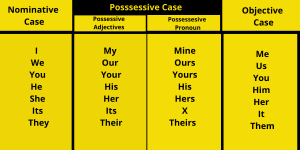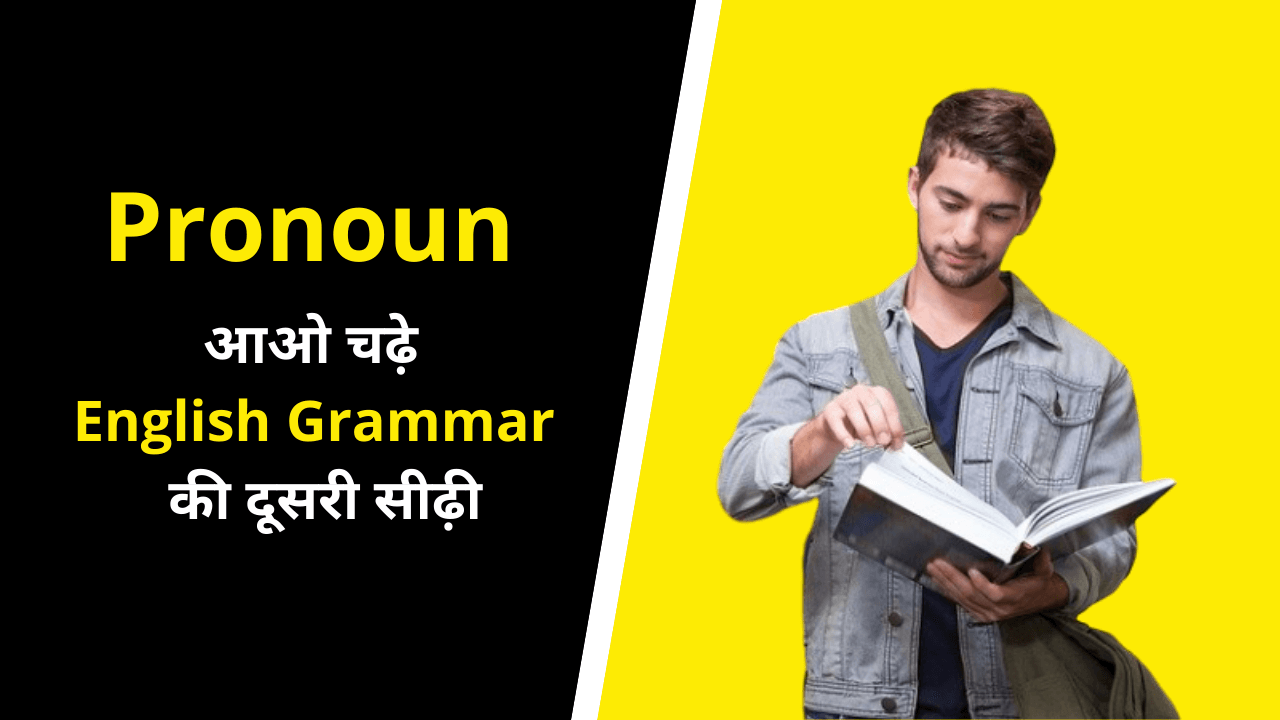पिछली बार हमने Noun के बारे में पढ़ा था, इस बार बढ़ते हैं pronoun in hindi यानी सर्वनाम की ओर। वाक्य बनाते समय हमारी अभिव्यक्ति बार-बार एक ही तरह के शब्दों से हो तो भाषा नीरस हो जाती है। किसी भी भाषा का असरदार प्रयोग करने के लिए हमें नए शब्द एवं वाक्य सीखते रहने चाहिये।
एक हद तक इसमें व्याकरण हमारी मदद करती है। वह हमें वाक्य बनाने का एक ढांचा देती है। सर्वनाम उन शब्दों को कहा जाता है, जो संज्ञा के स्थान पर प्रयुक्त होते हैं। ये आठ प्रकार के होते हैं।
Definition of pronoun
परिभाषा – Pronoun उस शब्द को कहते हैं जो किसी noun के बदले में प्रयोग होता है। Pronouns are words that take place of a nouns. Example:-
(i) I know Ram. He is a good boy.
(ii) Sita is my daughter. She is very intelligent.
(iii) This is my dog Jim. It is clever.
(iv) There are fifty students in the class. They are reading.
कभी-कभी pronoun का प्रयोग वाक्य में किसी अन्य pronoun के बदले या पूरे clause के बदले भी किया जाता है। जैसे-
(1) He who leads a regular life lives long.
(ii) He has not written to me for a month now, which shows that he does not care for me.
वाक्य (i) में who का प्रयोग ‘he’ के बदले हुआ है और वाक्य (ii) में which का ‘He has not written to me for a month now’ के लिए।
Note-जिस noun या pronoun या clause के लिए किसी pronoun का प्रयोग होता है उसे उस pronoun का Antecedent कहते हैं।
KINDS OF PRONOUN
Pronouns के आठ प्रकार होते हैं। उनके नाम हैं –
(i) Personal ( पुरुसवाचक ) जैसे – me, you, he, she, it, they, etc.
(ii) Reflexive या Emphasizing ( निजवाचक ) जैसे – myself, yourself, herself, itself, themselves, oneself, etc.
(iii) Relative ( संबंधवाचक ) जैसे – who, which, that, as, etc.
(iv) Demonstrative ( संकेतवाचक )जैसे – this, that, so, such, the former, the latter.
(v) Interrogative ( प्रश्नवाचक ) जैसे – who, which, what.
(vi) Indefinite ( अनिश्चयवाचक )जैसे – some, any, one, they, all the whole, something, nobody, etc.
(vii) Distributive ( व्यष्टिवाचक ) जैसे – each, either, neither, everyone.
(viii) Reciprocal ( परस्परबोधक वाचक) जैसे – each other, one another.
PERSONAL PRONOUNS
PERSONAL PRONOUNS – जिस तरह हिन्दी में पुरुषवाचक सर्वनाम के तीन पुरुष होते हैं उसी तरह अँगरेजी में personal pronoun के तीन persons होते हैं –
(i) First person (उत्तम पुरुष), (ii) Second person (मध्यम पुरुष), (iii) Third person (अन्य पुरुष)।
(i) जिस Pronoun से बोलनेवाले का बोध हो, उसे first person का pronoun कहते हैं। ये है – I, we, me, us, my, our, mine, ours.
(ii) जिस pronoun से उस व्यक्ति का बोध हो जिससे कुछ कहा जा रहा हो, उसे second person का pronoun कहते हैं। वे हैं – you, ye, thou, thee, thy, your, thine.
(iii) जिस pronoun से उस व्यक्ति या वस्तु का बोध हो जिसके बारे में कुछ कहा जा रहा हो, उसे third person का pronoun कहते हैं। वे हैं-he, she, it, they, them, him, her, his, their, its, hers, theirs.
Note – (a) सभी nouns, third-person के होते हैं।
(b) अगर pronoun का antecedent कोई pronoun रहे तो उसका वही person होता है, जो उसके
antecedent का है। जैसे –
(i) I, who am a good man, should not do this.
(ii) You, who are a good man, should not do this.
(ii) He, who is a good man, should not do this.
पहले वाक्य में, who का प्रयोग, 1 के लिए हुआ है, इसलिए यह first person का pronoun दूसरे वाक्य में you के लिए, इसलिए यह second person और तीसरे वाक्य में he के लिए, इसलिए यह third person में है।
(c) Noun की तरह pronoun का भी number और case होता है। यह आप pronoun in hindi की chart से स्पष्ट हो जाएगा।

Note – (i)ऊपर pronoun in hindi chart में my, our, thy, you, his, her, its, their pronouns है, परन्तु इनका प्रयोग adjective की तरह होता है, इसलिए उन्हें possessive adjective भी कहा जाता है।
(ii) उपर्युक्त तालिका में mine, ours, thine, yours, his, hers, theirs, pronouns हैं और इनका प्रयोग possessive pronoun की तरह होता है (possessive adjective की तरह नहीं)।
REFLEXIVE PRONOUN AND EMPHASIZING PRONOUN
REFLEXIVE PRONOUN या EMPHASIZING PRONOUN my, thy, your, him, her, it, और one में -self जोड़कर, और our, your, them में –selves जोड़कर बनाए जाते हैं। इन pronouns के form तो बिल्कुल एक-से हैं , लेकिन इनके function में बहुत अन्तर है।
Rule-(i) यदि किसी verb का subject और object एक ही व्यक्ति या वस्तु रहे तो object के लिए हम reflexive pronoun का प्रयोग करते हैं। जैसे-Ram ruined Ram. इस वाक्य में ruined का subject, Ram है और object भी Ram है। तो यहाँ object, Ram के बदले हम himself का ही प्रयोग करते हैं।
(ii) Emphasizing pronoun का प्रयोग noun या pronoun के बाद उसे जोरदार बनाने के लिए होता है। Reflexive pronoun की तरह यह कभी verb का object नहीं होता, preposition का object भले ही हो।
DEMONSTRATIVE PRONOUN
DEMONSTRATIVE PRONOUN – This is my book. These are schoolboys. इन वाक्यों में this और these का प्रयोग क्रमश. ‘book’ और ‘schoolboys’ को सूचित करने के लिए हुआ है। अतः ये DEMONSTRATIVE PRONOUN है।
This, that, these, one, ones, such, some इत्यादि demonstrative pronoun हैं।
Note – जब ये शब्द किसी noun के बदले में आते हैं तब इन्हें demonstrative pronoun कहा जाता है। जब ये किसी noun की विशेषता बताते हैं, तब इन्हें demonstrative adjective कहा जाता है।
निम्नलिखित वाक्यों का अध्ययन ध्यानपूर्वक करें-
(a) His coat is red, mine is a black one (Demons.pronoun)
(b) Only one man is needed. (Demons. adjective)
(c) The climate of Puri is better than that of Patna. (Demons. pronoun)
(d) That boy could not be found. (Demons. adjective)
वाक्य (a) और (c) में क्रमश: one (demonstrative pronoun) का प्रयोग coat शब्द के बदले में हुआ है और that (demonstrative pronoun) का प्रयोग climate शब्द के बदले में हुआ है। वाक्य (b) और (d) में क्रमश: one और that का प्रयोग विशेषण (adjective) के रूप में हुआ है।
INTERROGATIVE PRONOUN
INTERROGATIVE PRONOUN- who (कौन, किसने), which (कौन, किसने) और what (क्या) INTERROGATIVE PRONOUNS हैं। इन तीनों शब्दों का प्रयोग भिन्न-भिन्न अर्थों में होता है।
(i) Who’ का प्रयोग मनुष्य के लिए होता है। जैसे-Who has done this work?
(ii) Which’ का प्रयोग मनुष्य तथा चीज के लिए होता है; लेकिन ‘which बहुतों में किसी एक या कुछ को भी सूचित करता है; जैसे-Which of the books do you want? Which of the boys were absent ?
(ii) What’ का प्रयोग मनुष्य और चीज दोनों के लिए होता है; जैसे-
What is he after ? -वह क्या चाहता है ? (कोई चीज)
What are you? -तुम क्या हो ? तुम्हारा क्या पेशा है ?
Note-निम्नलिखित वाक्यों में अर्थ की विभिन्नता पर ध्यान दीजिए-
(a) Who is he ? -वह कौन है, अर्थात उसका क्या नाम है?
(b) Which is he ? -बहुतों में वह कौन है? अनेक एकत्र व्यक्तियों में से किसी खास व्यक्ति का पता लगाने के लिए इस प्रकार प्रश्न किया जाता है।
(c) What is he? – वह क्या है ? उसका क्या पेशा है ?
RELATIVE PRONOUN
RELATIVE PRONOUN – who, which आदि pronouns conjunction का भी काम के RELATIVE PRONOUN कहलाते है; जैसे-
This is the boy who has taken my book.
That was the pen which Ram gave me. The book that you have is good.
Tell me what you want. (What that + which)
INDEFINITE DEMONSTRATIVE PRONOUN
INDEFINITE DEMONSTRATIVE PRONOUN-निम्नलिखित वाक्यों को पढ़ें-
One must be attentive to one’s studies.
None was allowed to go out.
All that glitters is not gold.
Among the candidates, few were selected for the interview.
Only Mohan can remain here, others may go home.
They (People in general) say that the earth is round.
ये सभी pronouns definite (निश्चित) nouns के बदले में नहीं आते हैं, बल्कि उनका प्रयोग indefinite (अनिश्चित) nouns को सूचित करने के लिए होता है, अत: ये INDEFINITE DEMONSTRATIVE PRONOUNS कहलाते है।
One, none, no one, any, some, anyone, someone, few, many, all, both other, another, others, nobody, they, you इत्यादि का व्यवहार अनिश्चित (indefinite) noun के लिए हो सकता है, अत: ये indefinite demonstrative pronouns हैं।
DISTRIBUTIVE PRONOUN
DISTRIBUTIVE PRONOUN- अग्रलिखित वाक्यों को पढ़ें –
Each of the boys has his own pen.
Either of you can do it.
Neither of you can go out.
Everyone of you can pass the examination.
दो या दो से अधिक में से एक को अलग सूचित करनेवाले Pronoun को DISTRIBUTIVE PRONOUN कहते है।
Note – (i) यह ध्यान रहे कि distributive pronouns सर्वदा singular number में रहते हैं। अतः, इनकी क्रिया (verb) भी singular number में ही होगी।
RECIPROCAL PRONOUN
RECIPROCAL PRONOUN- निम्नलिखित वाक्यों को पढ़ें –
Ram and Sita loved each other.
The four girls were fond of one another.
उपर्युक्त वाक्यों के अध्ययन से दो बातें मालूम होती हैं-
(i) दो व्यक्तियों के बीच की बात को सूचित करने के लिए each other का प्रयोग होता है, और दो से अधिक के बीच की बात को सूचित करने के लिए one another का प्रयोग होता है।
(ii) Each other और one another का प्रयोग दो छोटे-छोटे वाक्यों को मिलाने के लिए भी होता
है। जैसे-
Ram loved Sita, Sita Ivoed Ram. (separate)
Ram and Sita loved each other. (combined)
याद रखें- (i ) यदि एक ही वाक्य में first, second और third person करना हो तो सर्वप्रथम second person, उसके बाद third person, उसके बाद first person प्रयुक्त होगा। जैसे- you, he and I shall play together.
(ii) Modern Grammar per each, every, all, everyone in everybody universal pronouns कहा जाता है, क्योंकि form (रूप) में singular होते हुए भी इनसे सभी का बोध होता है। जैसे -Everybody went away का अर्थ all went away.
(ii) Moderm Grammar के अनुसार ‘कुछ पदार्थ’ या ‘कुछ स्थान’ सूचित करने के लिए यदि nothing, something, anything, nowhere, somewhere आदि का प्रयोग pronouns की तरह हो तो वे partitive pronouns कहलाते हैं। जैसे-
Did you see anything ? I saw nothing
Did he go anywhere ? Yes, he went somewhere.
I hope you guys really enjoy this article on pronoun in hindi and i think this article is suitable for students who are able to write decently and would like to work on English grammar and speaking skills.
Also read
Rules and use of Article ‘A/An & The
